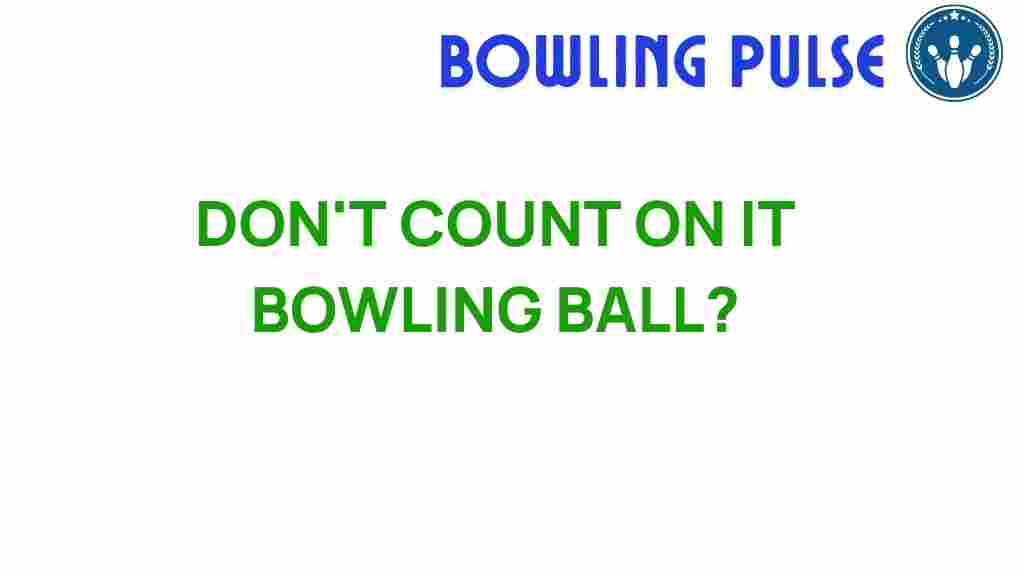The Surprising Science Behind the Don’t Count on It Bowling Ball
Bowling is a sport that combines skill, technique, and a deep understanding of physics. One of the most interesting aspects of bowling is the equipment used, particularly the bowling ball. Understanding the science behind the bowling ball not only enhances performance but also helps players refine their technique. In this article, we will delve into the various aspects of bowling balls, including their dynamics, the physics involved, and practical bowling tips to improve your game. We’ll also explore player strategies and how different equipment can affect performance.
The Physics of Bowling Balls
The physics of a bowling ball is a fascinating study that involves various physical principles. The key factors that influence the performance of a bowling ball include:
- Mass: The weight of the bowling ball affects how much momentum it carries. A heavier ball will knock down more pins, but it requires greater strength and technique to control.
- Material: Bowling balls are made from different materials, including polyester, urethane, and reactive resin, each affecting the ball’s grip and reaction on the lane.
- Surface Texture: The texture of the bowling ball’s surface can influence how it interacts with the lane, affecting both friction and hook potential.
- Core Design: The core of the bowling ball plays a crucial role in ball dynamics. Different core shapes can influence how the ball rolls and hooks.
Understanding Ball Dynamics
Ball dynamics is a key concept in understanding how a bowling ball behaves once it is released. Several factors are at play:
- Initial Velocity: The speed at which a bowler delivers the ball affects its trajectory and impact with the pins.
- Axis of Rotation: The angle at which the ball spins can determine its hook potential. Players must learn to control their spin to optimize performance.
- Angle of Entry: The angle at which the ball enters the pin deck is crucial for maximizing pin action and striking.
Bowling Techniques for Better Performance
Improving your bowling game often comes down to mastering technique. Here are some essential bowling tips that can help enhance your performance:
- Grip: Ensure you have the right grip based on your hand size and comfort. A proper grip will enable better control over the ball.
- Stance: Your starting position should feel balanced and comfortable. A solid stance sets the foundation for a successful delivery.
- Approach: Develop a consistent approach. Focus on your footwork and timing to ensure a smooth delivery.
- Release: Work on your release technique to maximize spin and speed. The release should feel natural and fluid.
Player Strategies for Different Bowling Balls
Knowing which bowling ball to use in different situations can significantly affect your game. Here are some strategies:
- Choosing the Right Ball: Select a ball that complements your style of play. For example, a reactive resin ball is great for hooking, while a polyester ball is more suited for straight shots.
- Adjusting to Lane Conditions: Different oil patterns on the lanes can affect how your ball behaves. Understand how to adjust your ball choice and technique based on those conditions.
- Experimenting with Weight: If you’re struggling with control, try using a lighter ball. It can help you focus on technique without sacrificing accuracy.
Equipment Considerations
When it comes to bowling, the right equipment can make all the difference. Here are some factors to consider:
- Ball Fit: A well-fitted bowling ball will enhance your grip and control. Consider getting your ball drilled to match your hand size.
- Shoes: Proper bowling shoes can improve your slide and balance during your approach. Invest in a good pair that offers the right support.
- Accessories: Consider using bowling gloves or wrist supports if you need additional stability or grip.
Troubleshooting Common Bowling Issues
Even experienced bowlers face challenges. Here are some common issues and solutions:
- Inconsistent Hook: If your ball isn’t hooking as expected, check your release technique and ensure your fingers are applying the right amount of rotation.
- Overthrowing: If your ball is traveling too fast, focus on your approach and try to slow down your steps to maintain control.
- Left or Right Misses: If your shots consistently veer to one side, reassess your stance and target alignment.
Conclusion: Mastering the Science of Bowling
Understanding the surprising science behind the bowling ball can significantly elevate your game. By applying the principles of physics, mastering ball dynamics, and refining your technique, you can enhance your performance on the lanes. Don’t forget the importance of choosing the right equipment and developing effective player strategies tailored to your style. With consistent practice and a focus on these aspects, you’ll be well on your way to achieving bowling greatness.
For more in-depth bowling tips and resources, check out this helpful guide. And remember, bowling is not just a sport; it’s a science waiting to be explored!
If you want to learn more about the physics behind sports, visit this external resource for additional insights.
This article is in the category Equipment and created by BowlingPulse Team
